hiroshima appeals

Came upon this beautiful piece at the Contemporary Japanese Posters exhibition in the city today. The designer of this poster Yusaku Kamekura with illustrator Akira Yokoyama have managed to very successfully capture a feeling of the moment that cannot be described in words alone. In that sense, it is a true poster and a magnificent piece of communication design.
Having visited Hiroshima alters the way you imagine the atomic bomb forever. It links you to the place and the incident that holds such importance in world history. The moment of destruction embeds itself in your memory, and August 6th is no ordinary date anymore. That we were to come upon this poster only a day after US president Obama visited Hiroshima is also interesting.
The exhibition Contemporary Japanese Posters is on at the Japan Foundation, New Delhi from May 13 to June 4, 2016. A second part of the same exhibit opens on June 10th to close on July 1st. Many thanks and wishes to the Japan Foundation for bringing this inspiring collection of posters to New Delhi. Poster Design: Yusaku Kamekura, Illustration by Akira Yokoyama
TOWITHFROM – significant little things

TOWITHFROM – our webstore long-in-waiting, has been online for a bit now. We call it a shop of significant little things – things similar to those we ourselves have found, discovered, loved and collected in zillions of boxes that share an ever reducing space with us.
The Japanese have a term for it – Zakka, which translates as ‘many-things’. Objects that exude a strong yet soft, cultural character and enhance personal lives and environments through their presence, and possession. A nostalgia of sorts. We could maybe describe it on a parallel with joys such as stamp, shell or coin collecting, the excitement of flea markets and thrift stores or even a profession such as archaeology.



An important line of products we are developing at TOWITHFROM are the ‘Made of India’ range. We design and develop these together with Indian craftspeople and they feature their own special TOWITHFROM label – a sign that the product carries a flavour of India that we would like to portray in signature TWF style.



As of now, shipping within India is free for products priced above INR 700 and INR 50 otherwise. As an introductory offer, we include a free two-colour 2014 calendar with all purchases. Click here to visit the TOWITHFROM store.
For regular updates, like the TOWITHFROM Facebook page or follow us on Twitter.
the silly brilliance of shisa kanko

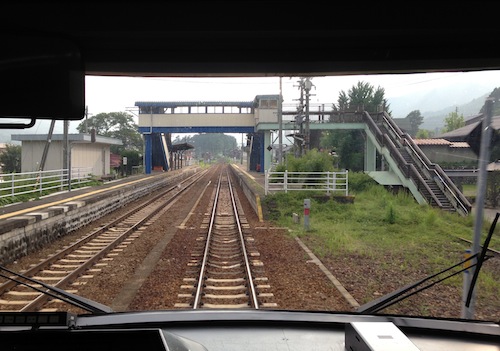
By chance or deliberation, its kind of exciting to be either at the front or the very end of a Japanese train. Most have large windows allowing luxurious views of the approaching or receding railway landscape. Finding ourselves at the absolute front of the Hida Wide View express from Nagoya to Takayama one afternoon, we had an interesting view of the train drivers and the scenery passing by. But immaculate perfectionists as they usually are, it was quite intriguing to see them perform strange pointing gestures accompanied with loud recitations.

Throughout our extensive train travel from Hokkaido in the North to Okinawa’s monorail far down south, they all seemed to be doing the same thing – pointing to and speaking out something, drivers and conductors alike. Even when operating the train alone, the singular train driver would point to something on the train dashboard or the track and speak out aloud to herself.
It was only when I found the time back in India did I get down to figuring out what this was. Its called Shisa Kanko – an occupational safety and error prevention method followed by Japanese industry, and of course most visibly by the Japan Rail system.
An article by Alice Gordenker in The Japan Times explains it sufficiently. Here’s an excerpt:
“Japanese railway employees have been using this technique for more than 100 years, but the exact origin is a little unclear. One story traces it to the early 1900s and a steam-train engineer named Yasoichi Hori, who was supposedly starting to lose his sight. Worried that he’d go through a signal by mistake, Hori began to call out the signal status to the fireman riding with him. The fireman would confirm it by calling back. An observer decided this was an excellent way of reducing error, and by 1913 it was encoded in a railway manual as kanko oto (“call and response”). The pointing came later, probably after 1925.
To give an example with English calls, let’s say your task is to make sure a valve is open. You look directly at the valve and confirm it’s open. You call out in a clear voice, “Valve open!” Then, still looking at the valve, you draw your right hand back, point to the valve in an exaggerated way and call out, “OK!” The theory is that hearing your own voice, and engaging the muscles of the mouth and arm, stimulates your brain so you’re more alert.”
Here is a video of the two drivers of the Hida Wide View express practicing the method on the Nagoya-Takayama route.
So the next time you admire the squeaky clean uniforms and brief-cases of the JR drivers, look out for the seemingly silly gestures as well. You’ll know its Shisa Kanko and you’ll know its yet another bit of Japanese brilliance.
All Photographs © Unlike Design Co.
(Alice Gordenker’s blog makes for some very interesting reading, especially if you seek answers to the countless oddities, occurrences and cultural phenomena in and around Japan)
hikari 465 to nagoya

Satisfying the craving for a long overdue mind boost, we took off to Japan for three weeks over July and August. Nine cities, seventeen express trains, eight bullet trains, six flights, six buses, two trams, one ferry, countless metro and monorail rides later, we quite literally ran out of memory space – absorbing and living the design and culture planet that Japan is.


One of the most memorable highlights of Japan was visiting Nagoya and its museums. Nagoya is an official UNESCO certified ‘City of Design’. If you look carefully, the design language is all around – from manhole covers that are a bit more interesting to the choice of doorbells and letterboxes. I first heard of Nagoya back in 2000 at design school because of the Nagoya Design Do! competition – held every two years and always themed on the softer meaningful aspects of design. One of the reasons Nagoya featured big on our plans.

Noritake garden was the first on our list – a carefully preserved and well groomed remnant of the old Noritake ceramics factory. Amidst the loud but strangely pleasant cicada sounds of the typical Japanese summer, we found our way to the beautiful gardens amidst which the old factory, gallery, museum and craft center are set.



We had a fantastic time at the craft center – learning the never-before things about slip casting, the making of a Noritake product, surface ornamentation techniques and even viewing a century old collection of Noritake plates.

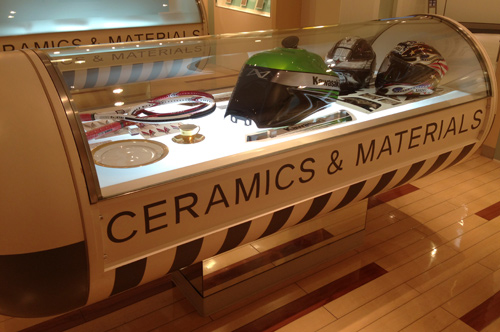
At Noritake Celabo, we saw the various applications of modern day ceramics – from circuit boards to fluorescent displays to grinding surgical needles and blades. They didn’t allow us to shoot inside, but that only made the brain take better notes.
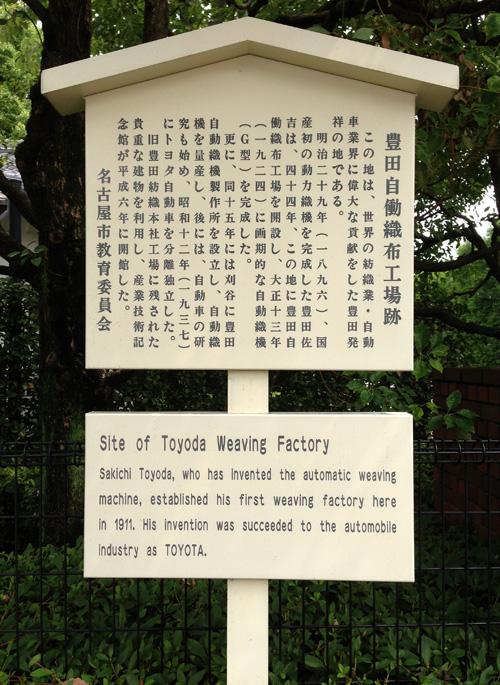

Richer from the previous days ceramic experience, we moved on to the Toyota Commemorative Museum of Industry and Technology. Of course we expected this to be about automobiles, but that really isn’t so. Toyota began as Toyoda – and Sakichi Toyoda, the man behind it all, was the inventor of the first automatic power loom. It was his son, Kiichiro Toyoda, who eventually led the way to Toyota the way we know it now.

And so the Toyota Commemorative Museum of Industry and Technology is divided into two main sections – the textile pavilion and the automobile pavilion. We started with the textile pavilion and in the few hours we spent there, saw a beautifully put together timeline of weaving and loom technology over the past century.


From Gandhi’s charkha to Sakichi Toyoda’s Model G loom (the first automatic) to rapier looms to faster-than-the-speed-of-thought water jet looms, the museum surpasses its ingrained ability to educate both the informed as well as the casual visitor. The staff struggle a bit with their English, but they don’t let that come in the way of ensuring your complete and thorough understanding of what you see.
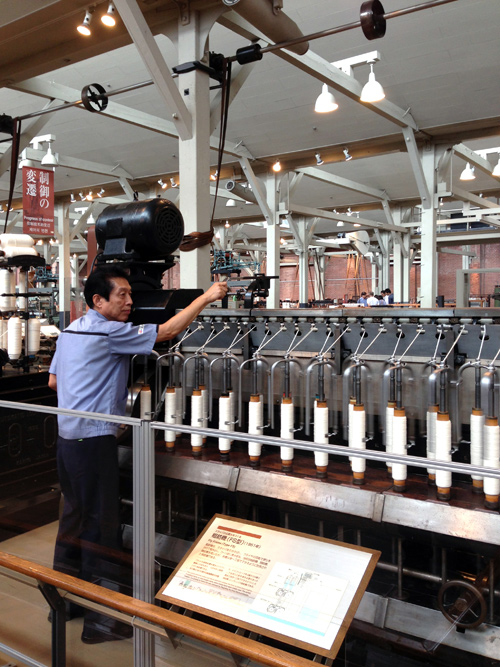

At some point in between the several riveting demonstrations, we couldn’t help but think of the situation back in current day industrial India, where most large corporations either don’t have the intention to share and educate of their work processes or never think of it as important enough to spend their profits on.

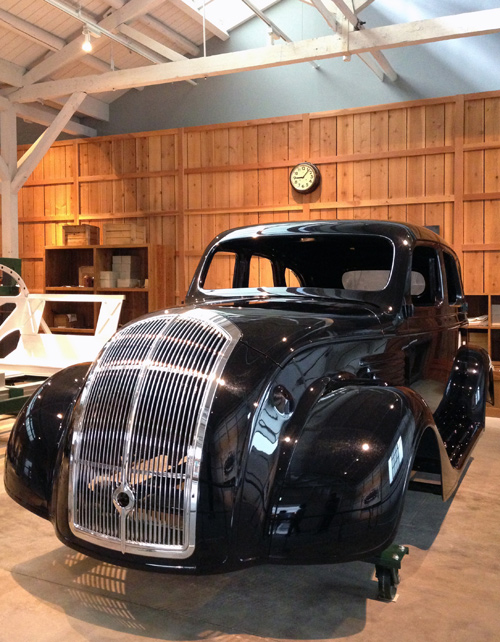

In the transition area between the textile and the automobile pavilion, there is a in-process model of Kiichiro Toyoda’s first car and the first Toyota ever – the Standard Sedan Model AA. It is displayed amidst a replica of the workshop where the first one was engineered for production. Nearby, there is a storage cabinet from those early years, a subtle visual reminder of Japanese work culture.



The automobile pavilion was no less than the textile pavilion in its open-ness to lay bare the materials and processes that go into the making of a Toyota automobile, or any automobile for that matter.



At the press of a button (and there are hundreds of them over the gargantuan exhibition hall), robotic arms, lights, motors and assembly lines come alive to demonstrate their contribution to car making, with signature Japanese pride.
If only Indian design institutes sponsored trips to such museums as official curriculum. And how much nicer if Indian industry opened up their rusty factory doors to the general public.
As for us, over these two fabulous days of educative brain bombing, we realised how important it is to stay close to factories and workshops, to keep our hands dirty and to keep alive the spirit of ‘making’. Even if we have to travel to Japan for it.
(Over the next few days in Japan, we visited the International Manga Museum at Kyoto and the Peace Memorial Museum at Hiroshima / Tickets for the Noritake Craft Center and the Toyota CMIT can be purchased as a combination at a special price of ¥ 800)
All Photographs © Unlike Design Co.
leave a comment